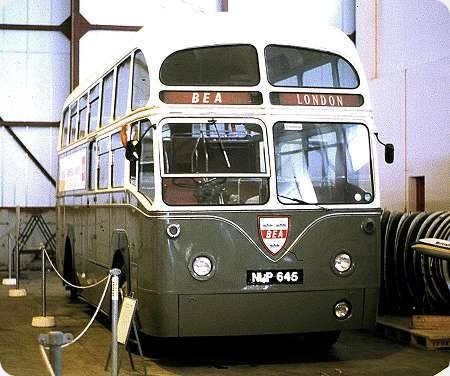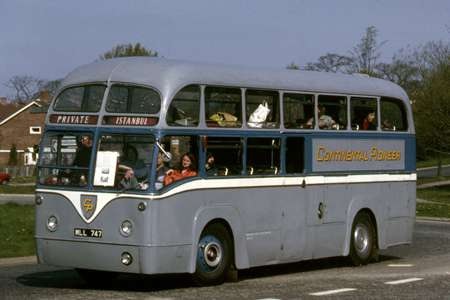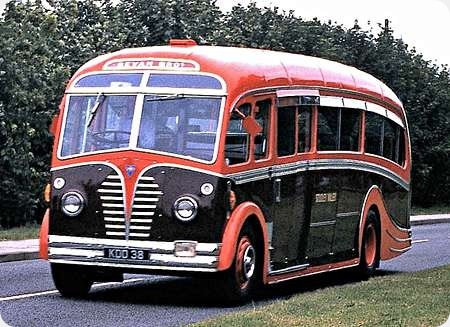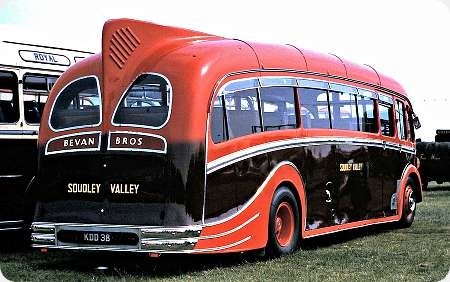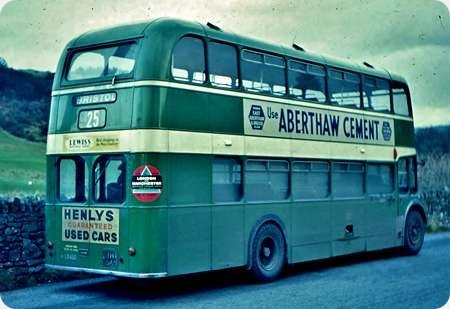
Bristol Omnibus
1957
Bristol Lodekka LDL6G
ECW H37/33RD
Among the 250 LD chassis built in 1957 as the 134th sanction were scattered six chassis to the new legal length on two axles of 30ft. They are generally referred to as type LDL, but I have seen LLD used in some factory documents. Bristol Omnibus L8450 is numerically the last and seen here looking miserable in late 1962 at the Holly Lane, Clevedon terminus of service 25.
I seem to remember that as well as being the first 30ft long Bristol double deckers, instead of the then standard vacuum assisted hydraulic system, they had compressed air servo hydraulic brakes, as later adopted for the Flat Floor (F) series chassis. Whether the LDL had air suspension, I can’t recall. Perhaps the last eight vehicles of the 138th sanction, designated LDS that went to Brighton, were used for air suspension trials, which also became a very successful standard on the F series (and eventually the RE!).
As a graduate trainee at BOC, I remember being allocated this vehicle for an evening overtime duty. As a novice driver, with a full load at Bristol Bus Station, to my embarrassment, I was unable to release the handbrake! A helpful inspector recommended depressing the footbrake at the same time and hey presto all was well!
The Lodekka front cowl hitherto had a single foot hold each side of the central number plate, but these six and subsequent flat floor models had a step to accommodate two feet to the nearside.
The ECW body is distinguished by having an extra short bay upstairs, otherwise you may miss the longer last bay downstairs. There was also an extra emergency exit – the saloon window behind the cab would open. It retained the original rear door window layout with the larger radius top corners towards the centreline, rather than the arrangement on the F series where the larger radius top corners were outboard.
The six vehicles must have been very successful prototypes as they stayed in service in one form or another for a good lifetime.
Photograph and Copy contributed by Geoff Pullin
31/03/16 – 06:50
Comparing this photo with photos of a ‘conventional’ 27ft LD it seems the extra length for the 30 foot LDL was all accommodated in the rear overhang. In other words the wheelbase seems to be the same for both models. Have I got this right or is it a trick of camera angle on the photos? If this is the case it must have pushed the Construction and Use Regulations to the limit!
Philip Halstead
31/03/16 – 06:51
Another great view from your collection, Geoff! I have a view of one of the VDV series in my pile of forthcoming submissions to Peter.
Pete Davies
01/04/16 – 07:01
Philip, I don’t think that is quite right. The LDL body had the same window spacing as the FL, and F-series window bays were slightly longer than those on an LD. The wheelbase of the LDL would therefore have been slightly longer than for an LD.
The FL had its rear axle further back still, so that it straddles the last long bay and the short bay. Possibly experience with the LDLs led to this change.
It’s also noteworthy that the driver’s cab offside windows in the LDL are of the pattern used for the F-series, i.e. with a straight lower edge.
Nigel Frampton
01/04/16 – 07:02
Philip, it does appear at first glance that the LDL Lodekka’s extra length was achieved simply by lengthening the rear overhang. However, the LDL had a longer wheelbase than the LD (18ft-6ins as opposed to 16ft-8.5ins) allowing the chassis outriggers and corresponding body pillars to be spaced further apart. You would never guess this initially from the photo though would you? Personally I prefer Bristol-ECW’s positioning of the short extra bay towards the rear on the LDL, rather than amidships as on AEC-Park Royal’s 30ft version of the Routemaster. Bristol-ECW’s treatment looks neater somehow. (Dons tin hat and waits to be hit over head with tin tray).
Geoff, I believe that whereas Bristol designated the long wheelbase model LDL, for some reason ECW referred to the design as LLD, the ‘alternative’ designation you mention in your text. Also, from memory the fitting of an emergency exit on the offside towards the front was a legal requirement on double deckers of this length, regardless of whether or not platform doors were fitted.
Your embarrassing moment with the handbrake reminded me of a somewhat similar embarrassment I had as a West Yorkshire Central Works apprentice, serving a three-month stint at Harrogate’s Grove Park depot. I had been asked by my fitter Johnny Berry to bring a dual-purpose MW up from the bottom end of the depot and park it up at the top end. All went well until it came to stopping the engine. Could I find a push or pull type stop button or a stop switch? I left the bus defiantly ticking over with the handbrake on, and asked Johnny – an easy going fitter who also had a love of buses and coaches – how to stop the little blighter. He just said, tongue-in-cheek, that it was up to me to find out! Not to be thwarted, I double-checked the handbrake was fully on, stepped on the footbrake, put the MW into gear and let the clutch pedal up and the bus gave up without a struggle. Johnny said he was impressed, but said if I had simply pulled the accelerator pedal fully up it would have stopped the engine! I would have known this if I’d been brought up on older Bristols, he mentioned with a wry smile. Lovely man. Happy days.
Brendan Smith
01/04/16 – 12:11
Brendan, I don’t know when a lower deck emergency door at the front became a legal requirement. This is a 1957 vehicle, and yet the NGT Group and NCT 30ft PD3’s of 1958, didn’t have one.
Ronnie Hoye
01/04/16 – 15:14
I wonder whether the lower deck emergency door requirement depended on seating capacity? In July 1959 Portsmouth Corporation took delivery of five Leyland PD3/6 with Orion bodywork. The layout was H36/28R, so just 64 seats in a 30-footer. There was no off-side lower-deck emergency door on these as delivered. However, between Nov 1961 and Nov 1962, they were all up-seated to H38/32R. Now seating 70 (still with an open rear entrance), they were all fitted with an off-side emergency door, in the front bay behind the driver’s cab. This modification was carried out when each was re-seated. The local enthusiast understanding at the time (of the school-boy variety) was that the seating increase was the cause of the emergency door fitment. However such hear-say does not necessarily have a basis in fact.
Michael Hampton
02/04/16 – 06:27
Michael, it may be that by 61/62, the regulations had changed, and in order for the Portsmouth vehicles to be up-seated they needed to comply with the regulations at that time. The NCT PD3’s were H41/32R Orion bodies. The NGT group were 13 Burlingham H41/32RD for SDO, the remainder were Orion H41/32R, but as mentioned before, none had a front emergency exit
Ronnie Hoye
02/04/16 – 06:28
Intriguing information indeed Ronnie and Michael, which has caused some head scratching at this end, leading to a splinter in me finger. I do remember Leeds CT’s 30ft rear entrance Roe-bodied CVG6LX/30s and Regent Vs (MCW and Roe-bodied examples) having emergency exit windows in the first offside bay. I also thought that LCT’s 30ft Roe-bodied Titan PD3s of 1958 had them, but have now seen photographic evidence that proves otherwise! Could it be that the Construction & Use regulations were changed at some point along the lines of "vehicles built after a certain date must have…."? The plot thickens as they say.
Brendan Smith
02/04/16 – 07:17
Sheffield had 71 rear entrance Regent Vs in 1960 – delivered between January and April. The 25 Roes had platform doors and a rear emergency door – but none behind the driver. The 26 Weymanns had no emergency exit behind the driver. The last to arrive were the 20 Alexanders which DID have the emergency exit behind the driver. One can only surmise that regulations changed during the build &/or delivery of these vehicles.
Mr Anon
02/04/16 – 09:08
This interesting aspect concerning additional emergency exits confirms my present day terror about riding on most modern double deckers carrying around ninety persons. As if the lack of a central normal exit isn’t bad enough – causing havoc to punctual running but that’s another topic – there is only the tiniest slender emergency door at the rear offside of the lower saloons. In many cases this "arrow slit" is further reduced at its lower end by a rigid armrest for the long seat for five. I just cringe at the thought of an engine fire, or of the front door being disabled in an accident as there could only by mass panic in the manner of recent tragic football ground carnages. The often found alternative "in emergency break glass" is a farce too – so if you survive the emergency incident per se you risk being cut to ribbons by the alternative. I freely admit to avoiding travelling on any bus where there are huge numbers of standing passengers in addition to to oversized buggies and "staircase gangway blockers – I’m only going a couple of stops." Melodramatic I may admittedly sound, but I’m sorry to say that today’s double deckers in particular are a disaster waiting to happen – and we won’t stray here onto today’s criminally overcrowded trains.
Chris Youhill
02/04/16 – 09:55
The Aldershot & District Loline I buses of 1958 had rear entrance bodies with doors but no offside emergency exit. The front entrance Loline IIIs of 1961 onwards had emergency exits on the offside rear. However, the batch of City of Oxford front entrance Dennis Loline IIs also of 1961, albeit of 27ft 6ins length, had no offside emergency door. The Halifax Front entrance PD3s of 1959 did have a rear offside emergency exit. Operator discretion seems to have applied up to about 1960, but somewhere about then the rules must have changed. I’ve tried to find the regulations on the internet, but historic data seems to be rather elusive.
Roger Cox
02/04/16 – 10:25
Further thoughts – the possible provision of a centre rear emergency exit may explain the absence of an offside door on the Oxford Lolines. My high mileage memory can’t now recall if they were so fitted.
Roger Cox
02/04/16 – 16:09
I think you may be onto something with your centre rear emergency exit theory Roger. ECW did not fit offside emergency exits on the Lodekka FSF/FLF bodies, and Northern Counties halfcab front entrance ‘decker bodies do not appear to have had them either. Both designs did however have their emergency exit door mounted centrally within the lower deck rear bulkhead. Going back to rear entrance double-deckers, LT’s first 30ft long Routemasters, delivered in 1961, had emergency exit windows on the offside. In Ken Blacker’s excellent book ‘Routemaster’ he describes the main features of the initial batch of RMLs, and then goes on to state: "Also new was the provision of a quick release emergency window in the second offside bay of the lower saloon to provide the secondary means of escape required by law for vehicles of this length". Unfortunately we’re still no nearer knowing when such legislation was introduced. As you say, related information on the internet does indeed seem to be rather elusive.
Brendan Smith
03/04/16 – 07:37
I think I’ve got it. It seems to be about lower deck seating capacity and the positions of other exits, and it dates from 1958.
Here is an extract from Regulation 26 of the Public Service Vehicle (Conditions of Fitness) Regulation 1958, which came into effect on 11th April of that year:
(a) A half-decked vehicle, a single-decked vehicle with permanent top and the lower deck of a double-decked vehicle shall be provided with not less than two exits (one of which may be an emergency exit) which shall not both be situated on the same side of the vehicle.
(b) Where, in the case of a single-decked vehicle and the lower deck of a double-decked vehicle, the seating capacity, in either case, exceeds 30 passengers, and the exits provided in accordance with condition (a) of this paragraph are so placed that the distance between lines drawn at right angles to the longitudinal axis of the vehicle and passing through the centres of such exits at gangway level is less than 10 feet, an additional exit shall be provided at a distance of not less than 10 feet
Peter Williamson
03/04/16 – 07:38
According to Commercial Motor, November 13th 1953, the Construction and Use regulations were to be changed as "The Ministry says that the dangers of having both exits at one end of the vehicle have been increased by the use of large underfloor-engined single deckers, and particularly crush-loaders. Consequently, it is proposed that in a single-decker or on the lower deck of a double-decker, each seating more than 28 people, one exit shall be at least 10 ft. forward of the other, taking the measurement opposite the centre of each exit at gangway level."
Hence why the FLF Lodekkas had the emergency door at the back, whereas the LDL had the additional door at the front.
Peter Delaney
04/04/16 – 06:36
Peter and Peter, thank you very much indeed for solving the emergency exit window mystery for us. In only a matter of days, the ‘OBP Supersleuths’ have won through yet again.
Brendan Smith
04/04/16 – 11:05
Thanks seconded! I’ve been wondering for some time whether Construction and Use regulations still exist, perhaps under another name. Googling has thrown up quite a lot on accessibility for the disabled, but nothing on other aspects of design and build. Could someone point me in the right direction? Thanks.
Ian Thompson
04/04/16 – 11:06
So the school-boy enthusiasts in Portsmouth weren’t wrong! But I doubt if any of them had read the C&U regulations – I certainly hadn’t. But thank you to both Peters for tracking down the detail, so that we are all now wiser, as well as just older.
Michael Hampton
04/04/16 – 17:04
The main C&U regs seem to date from 1986, with some amendments in 1988, but a new set came out last year. I’ve not had a chance to look at them – out on the road!: SEE: www.legislation.gov.uk/uksi/
Christopher Hebbron
30/04/16 – 12:14
With the exception of the Eastern National example 236 LNO which had the same 19ft 2in wheelbase as the FL, the other LDLs had an 18ft 8in wheelbase. There was also the 1966 LDL, a paper exercise for what I’ve read described as a Bristol Arab V, that would have had an 18ft 6in wheelbase.
Stephen Allcroft
29/08/16 – 06:32
I was a conductor at H & D Poole in the late 1970’s and we had a couple of these lengthened versions. The one thing I do remember is that they rode much more smoothly than the normal versions, even the rougher drivers couldn’t send you down the bus. Unfortunately although I passed my test in early 1979 I never got to drive one.
Joe C
22/01/19 – 07:23
Unlike the standard RMLs, the RCL Green Line version didn’t have an emergency window fitted to the offside second bay. In his book "Routemaster", Ken Blacker states that "…they had no emergency window fitted into the offside of the lower deck as the one on the rear platform met the legislation". It would seem from previous comments that it more likely one wasn’t required as they only seated 29 in the lower deck. If London Country (and later London Transport in 1980) had upseated them to the normal capacity of 72 on being relegated to bus duties presumably an emergency window would have needed to be fitted. Luckily that didn’t happen and they continued to offer a far superior ride!
Paul Evans
